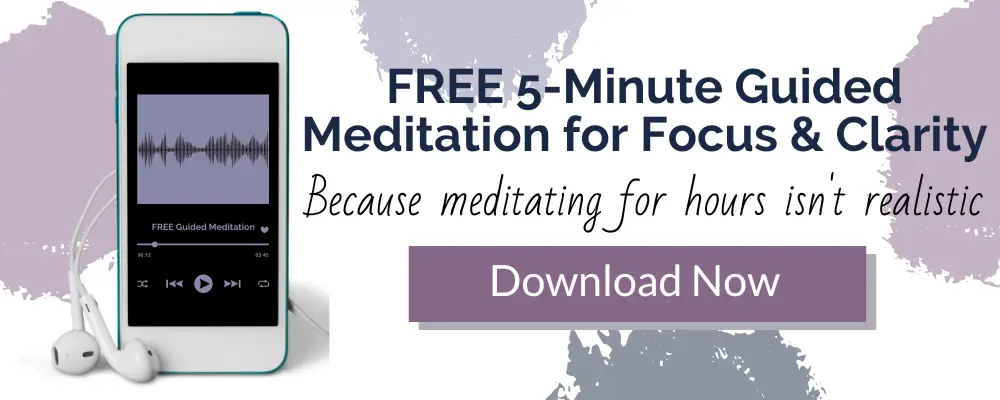35 Inspiring One Word Mantras for Meditation: Find Your Calm

Meditating can be hard, especially if you’re just starting out. But it doesn’t have to be so intimidating! With the right tools, you can the journey easier and more enjoyable. One of those tools is using short one-word mantras.
A one word mantra is a meaningful single word that is repeated during meditation to help focus your attention and keep your mind from wandering. It can be any single phrase like “calm” or “peace,”. These simple phrases can help you to stay present and bring your awareness back to the current moment.
Using a simple chant can be a great way to stay focused and get the most out of your routine. It can also be a powerful reminder of your intention and a source of motivation when things get tough. So, if you’re looking for a way to make your practice easier and more meaningful, this could be the key.
What is a Mantra?
A mantra is simply a sound that is repeated to help with focus and concentration. It’s a tool used to anchor the mind, calm the body, and reduce stress. It comes from the Sanskrit language and is derived from: “manas” meaning mind and “trai” meaning to protect or liberate. In essence, it is a tool used for the liberation of the mind.
What is the purpose of a mantra?
The primary purpose is to help quiet a busy mind. Our mind tends to race from one thought to another, making it difficult to find peace. By repeating a sound, it becomes easier to focus our thoughts and let go of distractions. Additionally, they help bring awareness to the present moment which is the foundation of mindfulness.
Why Use One Word Mantras?
Sound is an excellent tool for helping focus the mind and reduce stress. While you can use longer phrases or sentences, short single word mantras have become popular because they are simple, easy and effective.
Using short, easy-to-remember phrases can be beneficial for both your physical and psychological well-being. They are also a more accessible option for beginners.
Mantra Meditation Benefits
There are numerous benefits to using this technique. It can help in two main areas:
Focus & Concentration
One of the main benefits is improved focus and concentration. When we repeat a sound or phrase, it becomes easier to tune out the distractions in our head and allow the mind to settle. If you struggle with your mind constantly wandering during deep thought, this is a great technique for you.
Physical & Mental Health
Meditation mantras are powerful tools that can have a positive effect both physical and mental health. Research has shown that making this part of your regular routine can help reduce stress, lower blood pressure, and improve overall well-being.
One word Mantras are Simple
One of the reasons that they are so popular is that they are simple to use. It’s easy to memorize, and because it’s such a short phrase, repeating it becomes almost automatic. This simplicity allows the mind to focus and stay present while practicing without as much effort.
How to Choose a Mantra
 What is a good mantra for meditation? Choosing one can be an overwhelming task, especially for beginners who are just starting out. There are so many possibilities available, each with its own unique meanings and purposes.
What is a good mantra for meditation? Choosing one can be an overwhelming task, especially for beginners who are just starting out. There are so many possibilities available, each with its own unique meanings and purposes.
But fear not, because in this section, we’ll be walking you through the process of how to choose one that resonates with you. From identifying your goals to selecting a term or phrase that aligns with your intentions, you’ll find all the tips you need to choose your perfect expression. The lists in this post provide several single word affirmations for beginners.
1. Identify What You Want to Achieve
First, it’s important to identify what you hope to achieve. For example, you might want to focus on reducing stress and relieving anxiety, or on the opposite end of the spectrum you may need an energy boost to charge towards your goals.
Identifying your intention will help you select something that feels right on a deeper level. You can think of it as a very short personal affirmation.
2. Consider Your Goals
It’s also important to consider your goals. Some people choose motivating chants that are empowering, while others chose ones that are more calming and grounding. The key is to find something that aligns with your intention.
If you have aspirations to conquer challenges at work the phrase you choose is going to be very different from someone who’s goal is to reduce their anxiety so they can better enjoy time with their family. Make sure the term you choose fits your personal goal.
3. Choose a Word or Phrase
Once you’ve identified your goals and intentions, it’s time to choose language that aligns with them. Remember that words have power. Your motivating chant can be an affirmation that resonates with you or a phrase that brings you a sense of peace. There are numerous options to choose from, so take your time and select something that feels right.
Best One Word Mantras for Meditation
Now that we’ve covered the benefits of using simple terms and how to choose the perfect sacred sound. It’s time to explore some of the best options available.
In this section, I’ll be sharing my top picks in both English and Sanskrit, as well as traditional bija seed sounds, or chakra sounds, along with their meanings and interpretations.
Whether you’re looking for a phrase to kick stress to the curb or one to help you feel more confident, this section will have one to suit your needs.
List of Mantras in English
Using a chant in English can be beneficial for several reasons. For one, you know the meaning and intention behind the thought, which can make it even more effective. These are easy mantras for meditation
English terms can also be easier to memorize and less intimidating than those in Sanskrit or other ancient languages.
1. Peace
Peace is simple and effective. It can help calm the mind and bring feelings of calm and relaxation.
2. Love
Love can be used to cultivate feelings of love and compassion for ourselves and others.
3. Gratitude
Gratitude can help us focus on the desired aspects of our lives and cultivate feelings of thankfulness.
4. Trust
Trust can aid us in feeling supported by the universe or a higher power.
5. Joy
Joy can help cultivate a sense of happiness and contentment in our lives.
6. Serenity
Serenity can help to cultivate a sense of peace and tranquility.
7. Compassion
Compassion can help to cultivate feelings of kindness and empathy towards oneself and others.
8. Abundance
Abundance can help to cultivate feelings of prosperity and abundance in one’s life.
9. Freedom
Freedom can be used to cultivate feelings of inner freedom and liberation.
10. Strength
Strength can help to cultivate feelings of inner strength and resilience.
11. Focus
Focus can help to cultivate laser-like attention and concentration.
12. Stillness
Stillness can help cultivate a sense of calm and quietness in the mind and body.
13. Healing
Healing can be used to cultivate feelings of physical, emotional, or spiritual healing.
14. Balance
Balance can help cultivate a sense of harmony and equilibrium in our lives.
15. Unity
Unity can be used to cultivate feelings of interconnectedness and oneness with all living things.
One Word Sanskrit Mantras
Sanskrit is an ancient language that has been used for spiritual enlightenment such as yoga and meditation for thousands of years.
Sanskrit chants have been used for centuries and have a rich cultural and spiritual history, and the use of them can help to connect us to that tradition. These are examples of mantras for mediation.
16. Aham
Means “I am” in Sanskrit and can be used to cultivate a deeper sense of self-awareness and mindfulness. It can also be used as a powerful tool for self-reflection and personal growth.
17. Om
This sacred sound is one of the most popular chanting mantras in yoga and contemplation. It’s believed to be the sound of the universe and can help bring awareness to the present moment. This is a sacred syllable in Hinduism and one of many powerful Buddhist mantras.
18. Namaste
Translates to “I bow to the divine in you”. Often used as a greeting in yoga and is a spiritual salutation. Can be used to cultivate feelings of gratitude and respect towards others, as well as a reminder of our interconnectedness with all living beings.
19. Joyoti
Meaning “devine light”, this word can represent the light of knowledge, illuminating the path of wisdom and understanding.
20. Sat
This single syllable phrase means “truth” in Sanskrit and can be used to cultivate feelings of honesty and authenticity.
21. Nirvana
Refers to the ultimate state of peace and enlightenment in Eastern philosophy. It can be used to cultivate a sense of inner peace and tranquility, as well as a reminder of our ultimate spiritual goal and to cultivate a sense of inner peace and detachment from worldly attachments.
22. Shanti
This means “peace” in Sanskrit and is a powerful tool for helping us find calm and tranquility in our lives.
23. Sukha
Means “happiness” or “pleasure” in Sanskrit. Can be used as a reminder to focus on joy and positivity in our lives helping to cultivate feelings of happiness and contentment.
24. Ananda
The Sanskrit phrase for “bliss,” ananda can be used as a tool for cultivating feelings of contentment and joy.
25. Satya
This chant means “truth” in Sanskrit and can help cultivate feelings of honesty, authenticity, and integrity.
26. Moksha
In Sanskrit it refers to liberation, enlightenment, and release from the cycle of birth and death. It can help cultivate a sense of spiritual freedom and detachment from worldly attachments.
27. Japa
Japa means “repetition” and is traditionally associated mantra meditation. It can be used to remind us to stay focused and committed to our spiritual healing.
28. Anahata
In Sanskrit it means “unstruck” or “unbeaten” and is associated with the heart chakra. It can help cultivate feelings of compassion, love, and connection.
29. Prana
Prana means “life force” or “vitality” and is traditionally associated with the breath. It can be used to cultivate awareness of the breath and promote overall positive energy and wellbeing.
Traditional Bija Seed Mantras
Bija seed mantras are one-syllable sounds associated with the chakras, which are seven power centers located along the spine that correspond to different aspects of our physical and spiritual selves. Each chakra is believed to have its own bija seed sound which, when chanted or repeated, can help to balance and activate that chakra.
30. Lam
This bija seed sound is associated with the root chakra and can be used to ground and connect with the earth.
31. Vam
is associated with the sacral chakra and can be used to cultivate creativity and emotional balance.
32. Ram
This bija seed sound is associated with the solar plexus chakra and can be used to cultivate feelings of power and confidence.
33. Yam
Yam is associated with the heart chakra and can be used to cultivate feelings of love and compassion.
34. Ham
This bija seed sound is associated with the throat chakra and can be used to cultivate honest communication and self-expression.
35. Om
Om is associated with the third eye and crown chakras and can be used to connect with the divine.
How to Use Your Mantra
Mantra meditation is an extremely easy technique. All you have to do is repeat a word or phrase to achieve a focused and calm state of mind. The following is a step by step guide to get you started:
1. Set an Intention
Before starting, it’s important to set an intention. This can be as simple as calming the mind or focusing on a particular goal or intention.
2. Choose Your Timing
You can meditate anywhere, anytime, if you have a quiet space to focus. Find a time that works best for you, whether it’s first thing in the morning or right before bed. Setting aside the same time everyday is ideal.
3. Find a Comfortable Position
Find a comfortable position, whether it’s sitting cross-legged on the floor or in a chair with your feet firmly planted on the ground. It’s important to find a position that allows you to be alert but relaxed.
4. Focus Your Attention
Once you’ve found a comfortable position, it’s time to focus your attention. Begin by taking a few deep breaths to relax your body and quiet your mind. As thoughts come up, allow them to pass and gently bring your focus back to your chant.
4. Repeat Your Mantra
Begin repeating your meditation mantra silently to yourself. You can repeat it in rhythm with your breath or at your own pace. Allow the term or phrase to fill your mind and help you stay present in the moment.
Try It for Yourself
Incorporating personal mantras into your routine is an effective way to reduce stress, cultivate relaxation, and find greater clarity. By choosing a term or phrase that aligns with your intention, you can create a routine that is both meaningful and impactful. Remember, finding the right chant is an individual process so take the time to experiment and find what works best for you.













